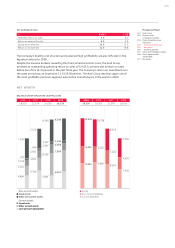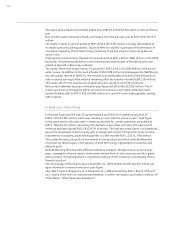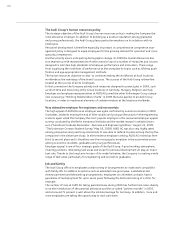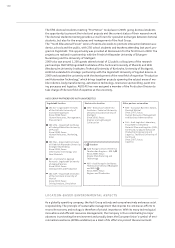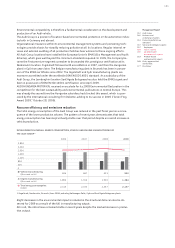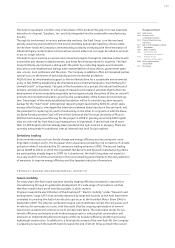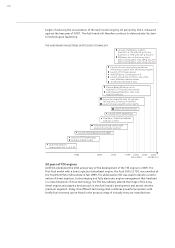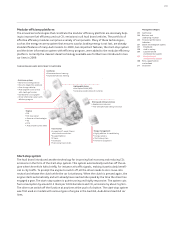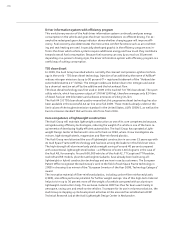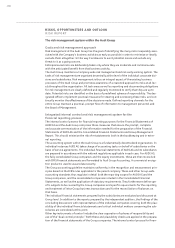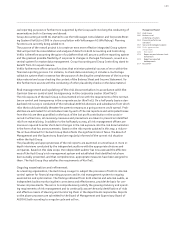Audi 2009 Annual Report Download - page 166
Download and view the complete annual report
Please find page 166 of the 2009 Audi annual report below. You can navigate through the pages in the report by either clicking on the pages listed below, or by using the keyword search tool below to find specific information within the annual report.
163
Management Report
132 Audi Group
140 Business and
underlying situation
153 Financial performance
indicators
157 Social and ecological aspects
157 Employees
159 Audi in society
160 Location-based
environmental aspects
163 Product-based
environmental aspects
168 Risks, opportunities
and outlook
177 Disclaimer
The Audi Group adopts a holistic view of all phases of the product lifecycle, from raw materials
extraction to disposal. Suppliers, too, are fully integrated into the sustainable manufacturing
process.
Through its involvement in various partnership ventures, the Audi Group is on the one hand
actively assuming responsibility for the environmentally appropriate handling of toxic waste.
On the other hand the Company is demonstrating solidarity in helping with the remediation of
industrial legacy contamination at sites whose owners either can no longer be called to account
or are no longer solvent.
The Audi Group is working on various environmental projects through its intensive contacts with
universities and research establishments, and holds fact-finding events for students. The Audi
Group furthermore maintains a dialog with the public by conducting regular environmental
discussions and neighborhood dialogs with representatives of associations, government agen-
cies, unions, local politicians and the press. The Company in addition offers all interested parties
special tours on the theme of sustainability and environmental protection.
AUDI AG lent its wholehearted support to the worldwide drive for a sustainable environmental
policy in fall 2009 by establishing the charitable environmental foundation “Audi Stiftung für
Umwelt GmbH” in Ingolstadt. The goal of the foundation is to protect the natural livelihood of
humans, animals and plants. It will support measures and research activities that further the
development of environmentally acceptable technologies outside the sphere of the car, and will
promote environmental education as well as the sustainability of the human-environment sys-
tem. One project of the newly established foundation will be to provide long-term research
backup for the “Oak Forest” international research project launched by AUDI AG, which seeks
among other things to investigate the interaction between stand density on the one hand, and
the potential for capturing CO2 and for biodiversity on the other. In conjunction with the Bavar-
ian State Forestry and the Chair of Forest Yield Science at the Technical University of Munich,
AUDI AG had already paved the way for the project in 2008 in planting around 36,000 English
oaks on a site not far from the Group headquarters in Ingolstadt. A second test site of more
than 13,000 English oaks has already been planted at the Győr location in Hungary. Plans are
currently being made for additional sites at international Audi Group locations.
Emissions trading
Environmental issues such as climate change and energy efficiency are becoming ever more
important in today’s world. The European Union assumed a pioneering role in matters of climate
protection when it introduced the CO2 emissions trading scheme in 2005. The second trading
period (2008 to 2012) in which the Ingolstadt, Neckarsulm and Brussels manufacturing plants
are participating already began in 2008. As it stands now, the Audi Group does not expect to
incur any costs from emissions trading in this second trading period thanks to the early adoption
of measures to improve energy efficiency and the targeted reduction of emissions.
PRODUCT-BASED ENVIRONMENTAL ASPECTS
Future mobility
For many years the Audi brand has been steadily shaping efficiency standards in automotive
manufacturing through its systematic development of a wide range of innovations, and has
therefore made future-proof mobility available in all its models.
Progress towards the electrification of the driveline (cf. “Electric mobility” under “Research and
development,” page 145 f.) has recently advanced by leaps and bounds, as the Audi brand dem-
onstrated in unveiling the Audi e-tron electric sports car at the Frankfurt Motor Show (IAA) in
September 2009. The internal combustion engine will nevertheless remain the core power unit
in vehicles for some years to come, with the result that the ongoing optimization of conven-
tional drive concepts will continue to be of pivotal importance. The Audi brand strives for sys-
tematic efficiency and adopts an all-embracing approach to reducing fuel consumption and
emissions in implementing the technologies within its modular efficiency platform and using
lightweight construction. In addition to a fully hybrid concept of the new Audi A8, the Company
is preparing to launch the Audi Q5 hybrid towards the end of 2010. It has set itself the overall




